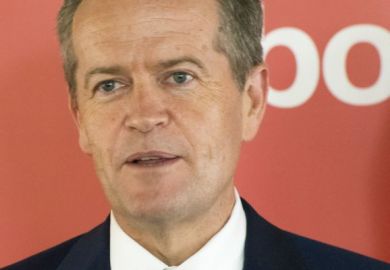One of the most striking aspects of the higher education sector is the regularity with which a new vice-chancellor or president is announced. Sometimes it seems that an email trumpeting a new leader – or the departure of an existing one – is a daily occurrence.
A new data analysis by Times Higher Education on the backgrounds of university leaders in the world’s top 400 institutions appears to bear this out: serving vice-chancellors have been in post for only five years to date, on average.
About a third of institutions have a leader who has only been in post since 2017 and about a fifth started in 2018 or this year.
It raises questions about whether such a turnover in university leadership is desirable or simply a natural consequence of a highly internationalised system where institutions are striving for the best talent.
The finding is just one of many fascinating insights from the exclusive THE data, which also looked at some of the typical characteristics of a top 400 leader such as age, gender, where they were educated, their disciplinary background and their previous role.
As well as the figures on length of service, the data suggest that an average president is a 62-year-old man who did an undergraduate science degree at a top 300 university, originally came from the same country as his current institution and was recruited externally.
However, there are also some intriguing variations between countries.
For instance, a top 400 university leader from the US is likely to be older (about 64 on average) and has spent about seven years in post. In Germany, too, the typical length of tenure is longer (closer to eight years), although this is probably linked to the practice of university rectors being elected for fixed terms. Rectors in Germany do tend to be a similar age to the overall average, though.
Meanwhile, among well-represented countries in the top 400, the youngest leaders tend to be in Sweden (58) and Australia (59.5) and the shortest typical time spent in a role is found in China and France (under three years on average). Sweden has the most female leaders while France has the least.
Science degrees dominate as the undergraduate training for top 400 leaders by about two to one, although arts, humanities and social science graduates are much more likely in the UK and the US, where roughly half of the leaders with available data had such a disciplinary background.
The dominance of the highest ranked universities in educating the future leaders is also clear.
Almost three-quarters of the top 400 institutions were being led by an alumnus of a university listed in the THE World University Rankings, while a top 10 university provided an undergraduate education to 30 leaders of institutions in the top 400. The University of Cambridge has the most alumni who are now presidents with seven, followed by Harvard (six) and Princeton (five).
On recruitment patterns, previously released figures from the dataset suggest that despite rhetoric about a global market on leadership, in general it was more likely for presidents to be originally from the same country.
But the new figures show that there is a slight slant towards finding leaders from other institutions, with more than 200 of about 350 universities with enough data being led by someone recruited externally.
However, this still leaves a sizeable minority of almost 140 institutions where leaders were promoted from within the same university, a trend that appeared to be more likely in the US and Germany than countries like the UK and Australia.
It was still very rare for universities to recruit from outside the higher education sector though. About 40 leaders had this background and many of these were still previously employed in the sector, such as at a funding council.
Timothy Devinney, professor and chair of international business at the Alliance Manchester Business School, said management studies had shown that companies “hire internally when they have confidence in their stability but also ensure that they have kept the best people”.
In higher education, this was something more common in the US, where universities were more likely to raise a senior manager’s pay to keep them from leaving. In the UK, “if you want a raise, you invariably have to go out and get an offer from someplace else and then your institution will match it”.
In Germany, the slant towards internal promotion is something that has been seen as problematic. A report released by the country’s Centre for Higher Education thinktank earlier this year found 40 per cent of Germany’s 81 university leaders had worked solely at their own institution since becoming professors.
Isabel Roessler, senior project manager at the centre who helped compile the report, said that this extreme insularity was now shifting. “The idea of what is important for a leader has changed…nowadays more management skills are needed,” she said.
Dr Roessler said that in the past few years it had also become more common “that it is not only an academic decision” to appoint a leader “but also consultancy agencies started helping universities. You can imagine that such an agency has a completely different view on what leadership is.”
Although the final candidate still needs the backing of scholars through a university’s senate, the fact that academics generally had a more outward and diverse outlook was also helping to change the leadership landscape, she added, although language and other barriers meant that recruitment was almost entirely within Germany.
Meanwhile, Dawn Freshwater, the vice-chancellor of the University of Western Australia, said that the selection process in each country was an important factor in trying to broaden the types of leaders in place, but “we also have to look at the ways they are supported”.
“It’s only too easy to offer up a ‘diversity candidate’, select that candidate as a token, and then dispose of them and return to ‘normality’,” she warned.
Professor Freshwater, who originally trained as a nurse and hails from a working-class background in England, added that better support would help ensure that there were “university leaders who are representative of society as a whole”.
“There is a tendency to think lazily where leadership is concerned,” she said. “For some, if the last leader was an upper-class white male, then that is who the next one should be. If your last university leader was a scientist, and he turned out to be a decent and capable chap – why not have another?
“Really examining leadership potential and capacity takes effort. It takes a broad and open mind, and a willingness to think outside the square and try something new and different. It takes acting like a university.”
simon.baker@timeshighereducation.com
The results of this analysis will be presented at the THE World Academic Summit, held at ETH Zurich from 10-12 September.
Find out more about THE DataPoints
THE DataPoints is designed with the forward-looking and growth-minded institution in view
POSTSCRIPT:
Print headline: Typical v-c is male, 62, a scientist – and in the job five years
Register to continue
Why register?
- Registration is free and only takes a moment
- Once registered, you can read 3 articles a month
- Sign up for our newsletter
Subscribe
Or subscribe for unlimited access to:
- Unlimited access to news, views, insights & reviews
- Digital editions
- Digital access to THE’s university and college rankings analysis
Already registered or a current subscriber? Login







